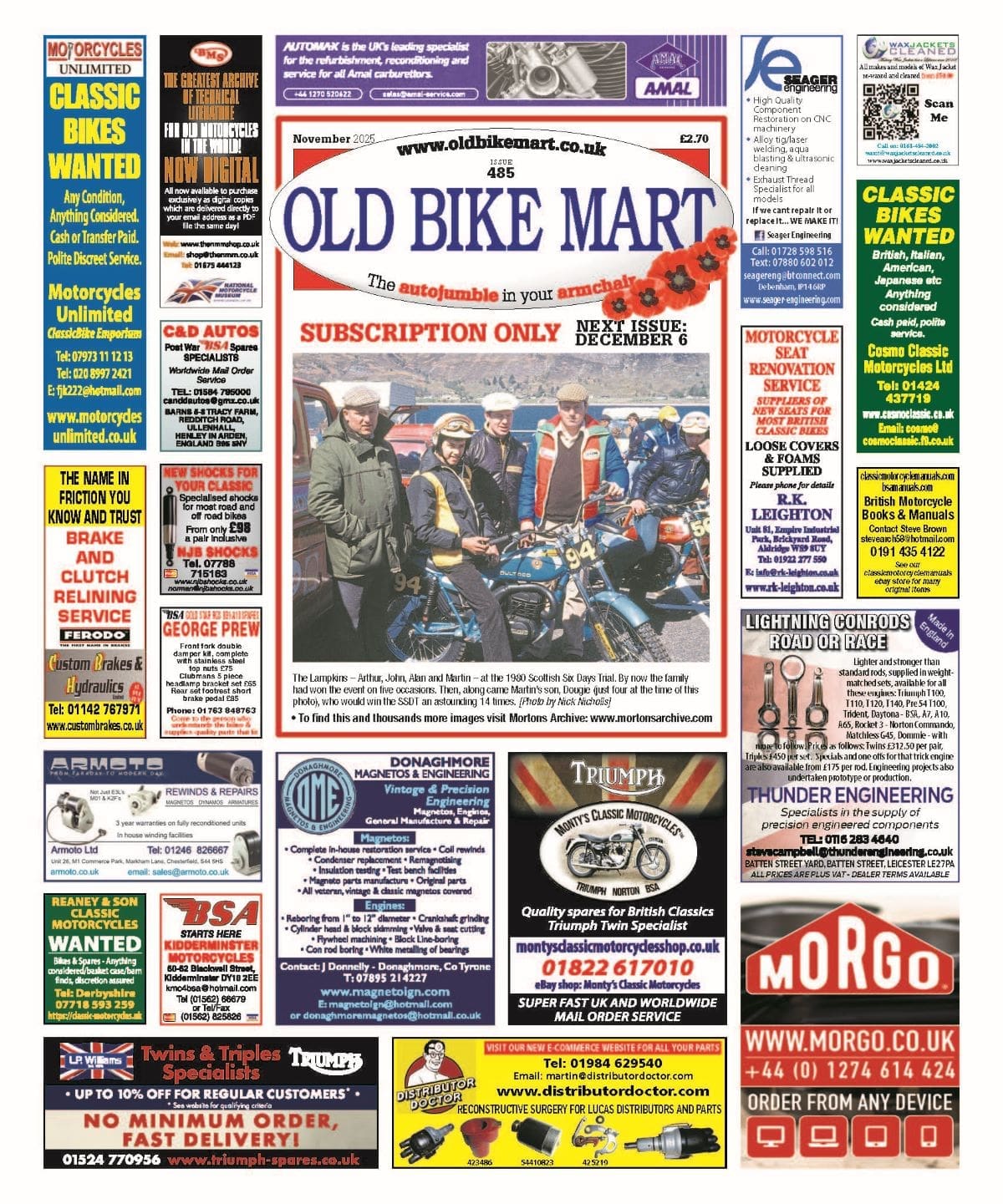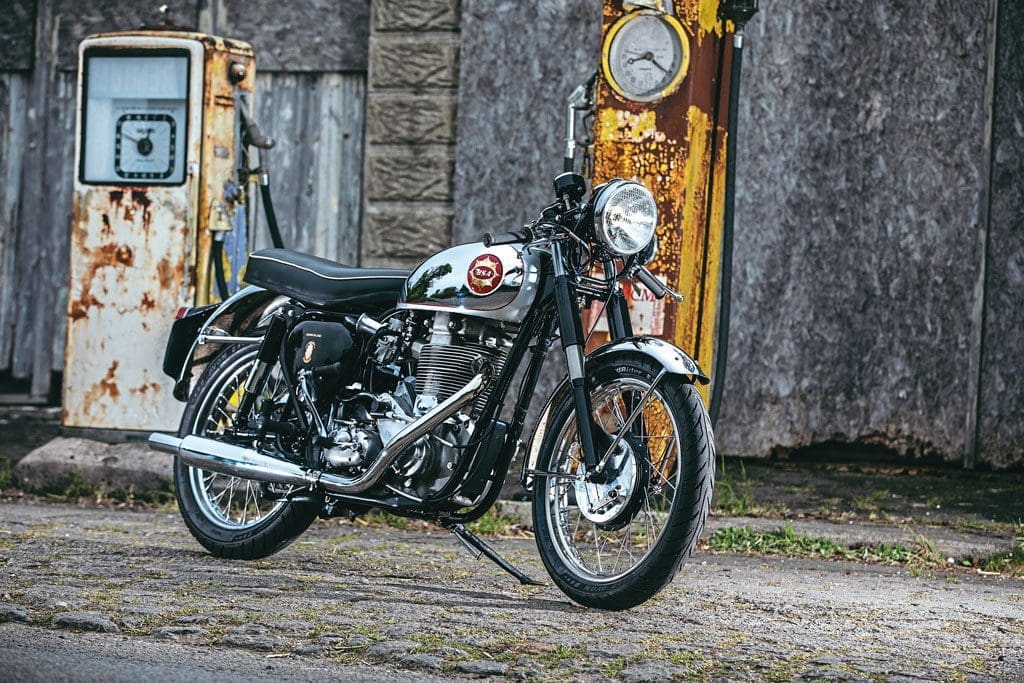
In a variety of guises which included scrambles, one and six-day trials, touring, racing and clubman’s trim, there is little doubt that the bikes which carried the name of Gold Star on their petrol tanks were amongst the greatest machines that ever rolled off the Small Heath production lines.
Most enthusiasts will know that the name of the iconic British single was earned when Wal Handley lapped the famous Brooklands circuit at over 100mph in 1937 on his BSA Empire Star, a feat which inspired BSA to produce the M24 Gold Star.
This was a 496cc alloy-engined machine with an electron alloy gearbox and a rigid frame made of light tubes, devoid of sidecar attachment lugs. The model was to run in 350 and 500cc forms until 1963, when due to the demise of the Lucas magneto, production of the hand-built engine was brought to an end.
Enjoy more classic motorcycle reading, Click here to subscribe to one of our leading magazines.
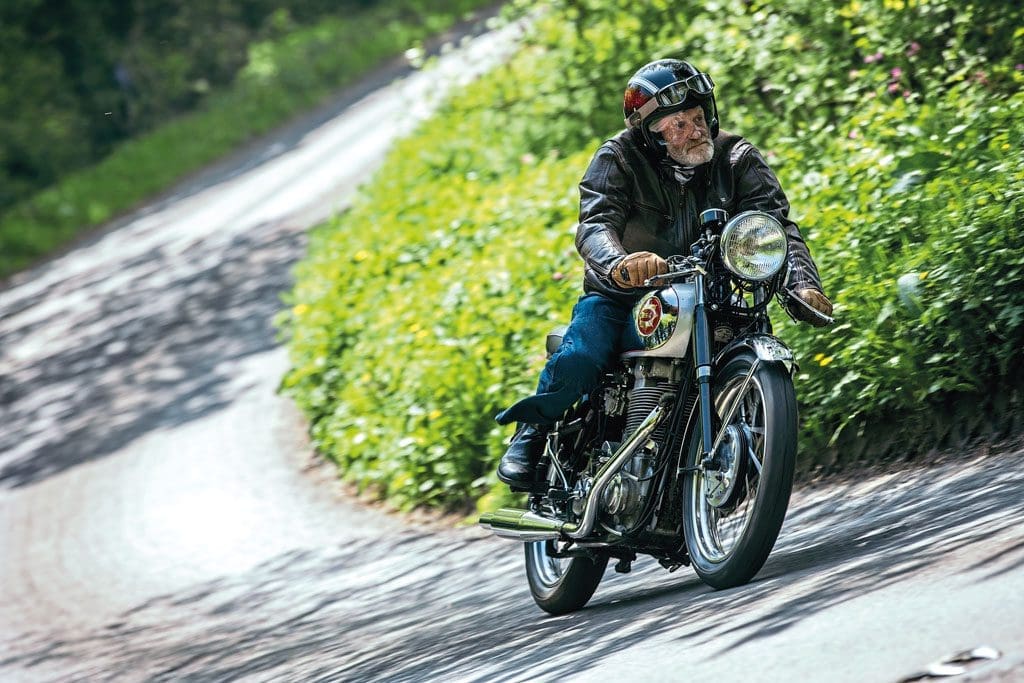
Much of the technical history of the Small Heath single has been written about in hundreds of articles in the motorcycle press and it was down to reading one of these that I handed over £169 of my hard-earned apprentice’s money in 1971, for a 500cc DBD34, carrying the registration number 228 BTT.
The sound of the twittering exhaust note was truly addictive but sadly the high ratios in the RRT2 gearbox made my daily ride to college in Bristol an ‘interesting’ experience in the city traffic and I soon discovered that if the sun went behind a cloud it usually meant that it was time for the spanners to come out to play…


I’d bought my bike from ‘Nobby’ Clark, at Weymouth Motorcycles in Frome, but my local BSA dealers was at Difazio Motorcycles at 25 Catherine Street, a well known location in the same busy market town, which from the early 1920s could proudly advertise as being the first of Small Heath’s dealerships in Somerset. During the 18 months I owned the 500cc single, it had several journeys to the Difazio workshop where it came under the skilled hands of Jack Difazio and his team of mechanics to sort out various ‘problems.’
This feature machine is a 350cc DB32 belonging to West Country enthusiast Andy Rowett – a man who has appeared in The Classic MotorCycle before, with his rare 700S Silk – and although it wasn’t supplied by the Frome dealership, I’ve discovered that 12 years ago the 350 was restored by Alec Castle, who after leaving school in 1948, worked at 25 Catherine Street.
Alec takes up the story: “When I left education, my father had arranged for me to start an apprenticeship at a local firm, but it was incredibly boring and after two weeks I handed in my notice and went looking for another job. I had an interest in motorcycles, so I decided to visit Pascal Difazio to see if he had any vacancies.
“It transpired he did and the following week I started work there preparing and repairing pushbikes, although within a couple of weeks I was promoted to the motorcycle workshop. Initially, I was working on the first Bantams but soon progressed to the C11s and the bigger singles, and then to the racing workshop where I was trained to fettle Jack Difazio’s iron-engine B31 – which ran on dope – and customers’ Gold Star engines. I also had a season or two as passenger to Jack on the grasstracks but when I got to 18 I was called up for my National Service which curtailed my motorcycling for a couple of years.”

While Alec was away on his National Service, Jack’s son Richard joined the family business and, over a coffee, he recalled those days 60 years ago when the shop was full of BSAs.
“In the 1950s we were one of Somerset’s main BSA dealers and before I left school I would walk down to the shop every afternoon, where I would process the spares parcels that had been ordered by customers and take them to the local post office. In addition to sending them to most places on the UK mainland, we had customers in both Sweden and Germany, where the main contact was Joseph Joy, a Sergeant with the British Army on the Rhine. Not only did we send parts to him, but once a year he would drive his car to the UK and after visiting us he would return with his Volvo filled to the brim with Goldie spares to distribute to enthusiasts in Germany.
“Both my grandfather and my dad were highly regarded by Cyril Halliburn, the competition chief at Small Heath, and we had so many spares for Gold Stars it was possible for us to build complete machines from parts in our stores.”
And it was on a ‘bitza’ constructed in the Frome workshop that Richard made his racing debut at Silverstone in the late spring of 1959.
“My dad had raced on both the grass and tarmac, so from an early age I was keen to go road racing and it was natural to use a Gold Star. During the winter of 1958/59, we made up a 350cc Goldie out of second-hand parts and I entered the MCC meeting at Silverstone in April of that year. Dad had also entered the same event and as his sidecar outfit filled up the trailer, it meant that I had to ride the Goldie the 100 miles from Frome to the circuit. When I went out for practice it was the first time I’d ridden on a racetrack and to say I was green is an understatement!
“It was held on the Silverstone Grand Prix course and it took me several laps to find out where to go, though I quickly learned it was important to keep out of the way of the rest of the field who all seemed to be circulating much quicker than me. The bike handled well but despite going everywhere as fast as I could the engine felt rather ‘woolly’ and suffered a lot of ‘megophanitis.’ I later learned dad had deliberately over-jetted the carburettor to make it slower so I didn’t get too carried away for my first time on the track!”
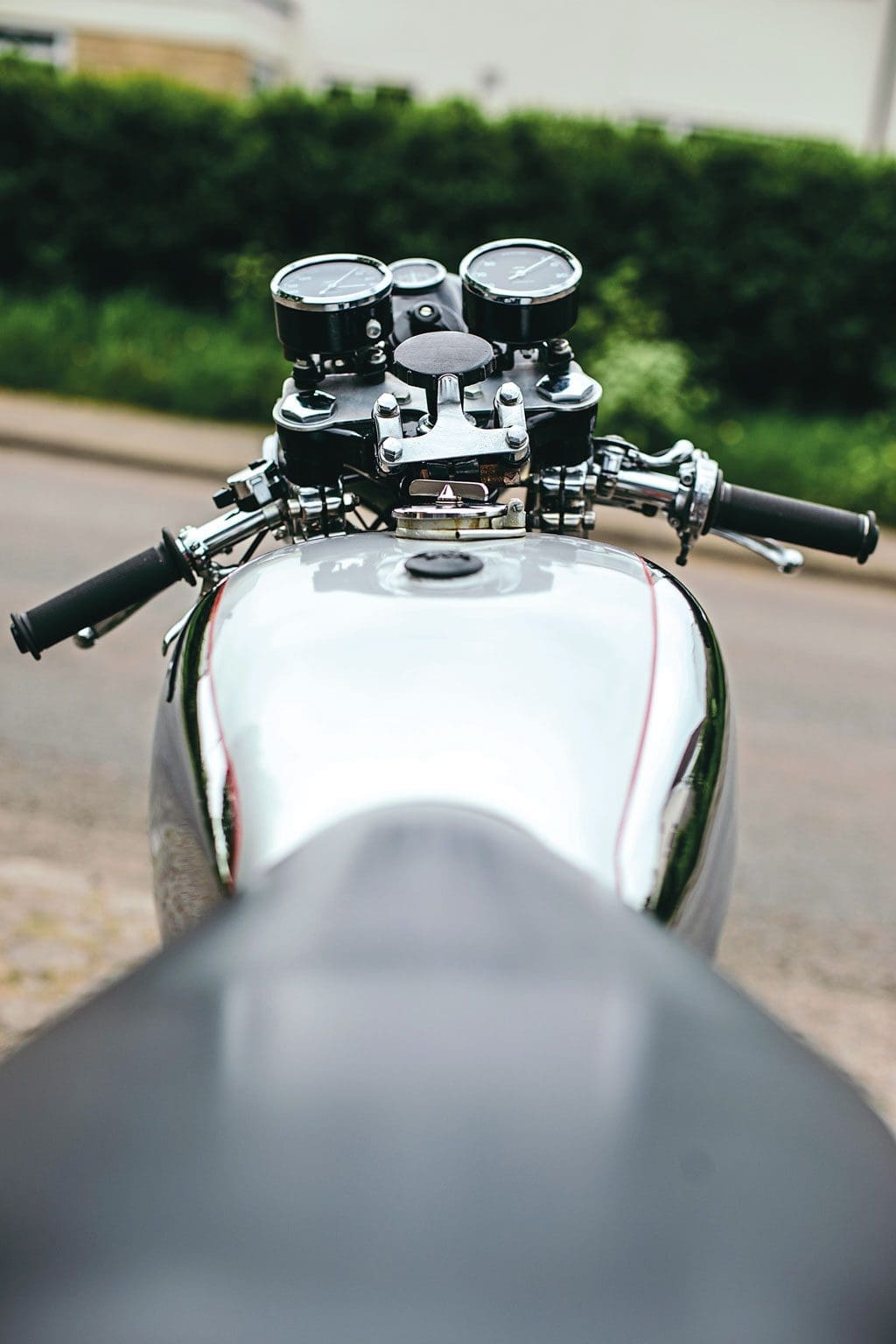
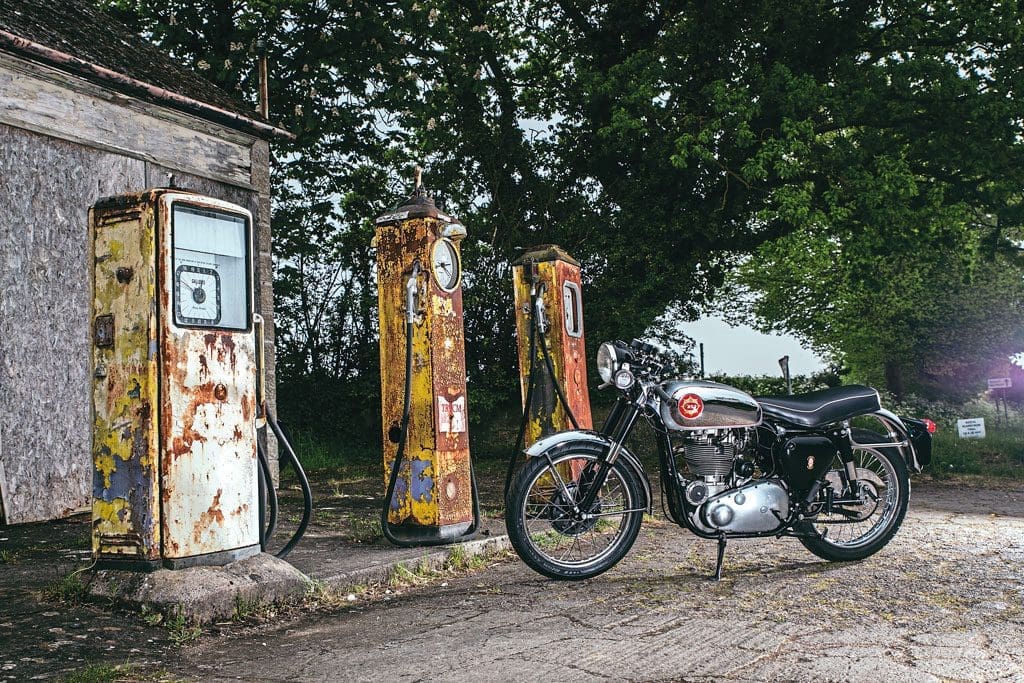
Richard didn’t set the world on fire on his race debut but he was soon on the pace and later in that season he qualified for his first final at an international meeting at Oulton Park.
“After we had sorted the jetting, the Goldie really flew and on top speed it could just about match the 7Rs and 350cc Manx Nortons I was racing against. In addition to the meeting at Silverstone, during that first season I also raced at Crystal Palace, Whitchurch aerodrome (near Bristol), Aberdare and Oulton Park. At Oulton I managed to finish seventh in my heat and as a result I qualified for the final, where after the ballot for the grid positions I ended up on the front row alongside a truly international field.
“With the right gearing I reckon the bike was good for around 110mph which was pretty good for a road-based 350cc single although it wasn’t enough to match the period front runners.
“The following year (1960) the fast Goldie motor was transferred into a Manx Norton rolling chassis and at virtually any national meeting the name of ‘R J Difazio’ began to figure in the top 10. The rest of the Goldie ‘bitza’ would be sold for spares and as it transpires it was also the year that the DB32 now owned by Andy Rowett rolled out of Small Heath. West Countryman Andy, who for many years has run a motorcycle repair business, bought the bike in 2016 although it was not the first Gold Star he had owned.
“In the late 1960s I’d just started my motorcycling career and shortly after passing my test I fancied getting a bigger bike and bought a DBD34 Goldie. It certainly looked the business but despite my best efforts it was incredibly temperamental to start. One of my experienced motorcycling friends, Bill Henham, came round to see if he could help and with carb flooded and choke on, he gave it an almighty kick. Unfortunately it kicked back and the 18 stone Bill was catapulted out of the saddle and into contact with my garage roof. Blood was everywhere and Bill had to be taken to the Royal United hospital in Bath to have stitches in his wound.
Too good to miss
“Later on another friend, Ernie Kimble, discovered that the timing was out – double its advance – and with this sorted at least I had a bike which started okay. It’s now interesting to think that when I went to part exchange the bike, I went to Grays Motorcycles in Bristol, but as they had four other Goldies unsold in their showroom, they refused to take it in. I later sold it to a friend for £150 and he still has it.”
Five decades and many bikes later, Goldie number two joined Andy’s ever burgeoning collection of classics although as he explained this came about very much by accident.
“I actually went to see a customer who wanted his Harley recommissioned but when I got to his workshop I was met by the sight of an immaculately restored 350cc Gold Star rubbing handlebars with the American V-twin. It transpired he’d had it for many years and after treating it to a nut and bolt restoration in 2006, the BSA single had been sat unused, and when he mentioned he was interested in selling, it I knew it was too good an opportunity to miss.
“The deal was done, so I returned home with not only a Harley to work on, but a superbly restored DB32 Goldie in my van.
“In Mick Walker’s book he described the 350cc version as the ‘ultimate’ Gold Star and despite the mag packing up on its first run, on the road it was – unlike my original DBD34 – a first kick starter and it cornered like it was on rails.”
Alec Castle had obviously done a superb job in restoring the bike back to its showroom condition but it is now a vastly different machine to the one he picked up in a sorry state 10 years previously.
“After I retired from my job running a quarry lorry business in 1989, I went back to my first love of restoring motorcycles and the 350cc Gold Star was one of the many I worked on. The owner had at one time raced the bike but it had been left lying in a shed for many years and when I went to collect it, I was met with a machine covered in rust and grime and in need of a total strip and rebuild.
“After working on so many Gold Stars during my days at Difazio’s, stripping and rebuilding the motor was straightforward and any spares I needed were readily available from specialist dealers. The mudguards were shot but other than that the rest of the running gear was salvageable and the only thing I had to farm out was the spraying of the petrol tank. With the engine back in the frame it started up with one prod of the kick-start but the running in miles around the newly opened Frome bypass revealed an oil leak in the drive side, which meant I had to strip it down again. I discovered that the drive side oil thrower wasn’t sealing the lubricant so I took apart the alloy block, turned a groove containing a rubber ring and clamped it up. I’m glad to say the result was a perfectly oil-tight engine.”
Since buying the Goldie in 2016, Andy has only covered a few hundred miles on the iconic British single, but from our brief ride it certainly goes as well as it looks. Alec has done a superb job rebuilding the engine and with petrol on and the piston eased over compression a hefty lunge with a size 10 boot had the bike bursting into life – that wonderful ‘twitter’ through the exhaust a reminder that this is a ‘proper’ motorcycle.
Fitted with the close ratio RRT2 gearbox, a decent amount of revs were need to get the 350cc up and running but once under way just third and fourth were required to bowl along at the national speed limit. The handling and braking are top notch and sweeping through the lightly trafficked B-roads on the Somerset/Wiltshire border, with the sun breaking through the trees, it makes one appreciate the DB32 has a strong claim to be the ‘ultimate Gold Star.’
To read more insightful and lavishly illustrated features of the finest machines, riders and racers, then pick up the latest edition of The Classic MotorCycle today. Click here to get yours.

